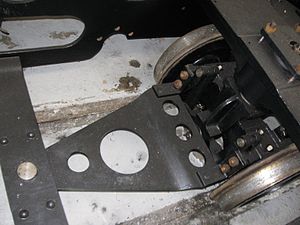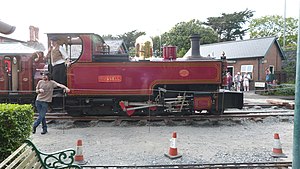Russell
 | |
 Russell in 2016 | |
| Home Railway | WHHR |
|---|---|
| Original Railway | NWNGR |
| Number | 12 |
| Status | In service |
| History | |
| Built by | Hunslet Engine Co. |
| Built | 1906 |
| 1925 | Cutdown for use on FR |
| 1942 | Requisitioned for war effort |
| 1954 | Purchased for preservation |
| 1987 | Returned to steam |
| Technical | |
| Wheel Arrangement | 2-6-2T |
| Fuel | Coal |
| Locomotives | |
Russell is a 2-6-2 tank locomotive operating on the Welsh Highland Heritage Railway (WHHR). It is the only surviving locomotive of the original WHR.
Originally built for the North Wales Narrow Gauge Railways (NWNGR), it was paid for by the North Wales Power and Traction Co. Ltd (NWPTC) but was placed into the possession of the NWNGR as part of a deal to restore that company's line to steam working after the NWPTC failed to complete the agreed electrification of the line.[1] It later worked on the original Welsh Highland Railway (WHR), when the superstructure was cut down in an unsuccessful attempt to bring it within the Festiniog Railway loading gauge. After the closure of the original WHR Russell was requisitioned for industrial use during the Second World War and was subsequently purchased for preservation. It was later restored to working order at the Welsh Highland Heritage Railway. A recent overhaul has returned Russell to a condition close to that when it was when built in 1906.
Russell was named after James C. Russell, the Chairman and Managing Director of the NWNGR.
History[edit]
Origins[edit]
Under an agreement of November 1904, the NWNGR was to be electrified and extended by the Portmadoc, Beddgelert and South Snowdon Railway as part of that Company's plan to connect Carnarvon with Portmadoc. In January 1906, James C. Russell, Chairman and Managing Director of the NWNGR, wrote a letter complaining about the delay in carrying out the agreed electrification works of his Company's railway. At the time the work on building the PBSSR's new line had been at least partially suspended since the Autumn because of objections by the National Trust to the Board of Trade about the Aberglaslyn tunnels and, apparently only just resolved a few weeks before through the mediation of Lloyd George as President of the BOT. The delays were primarily because the PBSSR's sole financier (and therefore controller) was the North Wales Power and Traction Co. Ltd (NWPT) and that Company had overspent in its efforts to build a power station at Cym Dyli, designed to supply North Wales Slate Quarries as well as the railway. The Company was concentrating on getting the power station completed so that it would bring in income. This it succeeded in doing the following September, but money could not be raised to finish the railway works.
Following Russell's letter, the NWPT Chairman had a meeting with him to make the best possible terms for postponing electrification of his line. This resulted in an agreement for a two year delay, and an undertaking from the NWPT that the PBSSR would recommence construction on or before March 1908, with completion of the railways within a reasonable time of that date. Amongst other terms in the agreement was the following:
"The Power Company to expend in restoring the North Wales Narrow Gauge Railway for present steam working and in providing one steam locomotive a sum up to but not exceeding £2,500."
Russell was therefore ordered by the PBSSR, paid for by the NWPT which had borne all the PBSSR's expenditure since 1905, and delivered to the NWNGR as that railway's property. Russell was ordered from the Hunslet Engine Company on 13 February 1906 by Gowrie Aitchison in his capacity as Manager of the North Wales Power & Traction Co. Ltd.
A specification had been prepared dated 31 January. Drawings were prepared and by 26 May the engine was already undergoing steam trials. Three days later, it left Leeds for North Wales. The remarkably short time in which the engine was built has produced several theories, the best one being the design was based on a class of 2-6-2T engines built from 1898 for the Sierra Leone Government Railway. Details differed, and it was larger than the Sierra Leone class, though of a narrower gauge. It was carried on outside frames to the driving wheels, with inside frames to the pony trucks, whilst Walschaert's Valve Gear was employed. Russell also bears a close resemblance in several aspects to the Hunslet 0-6-2T "Leeds No.1" used on a reservoir tramway in Yorkshire.
Russell appears to have been a replacement for the existing engine Beddgelert, built by Hunslet in 1878, which worked the important slate traffic on the Bryngwyn Branch. This engine was scrapped on the arrival of Russell, probably being beyond economic repair.
Service up to World War II[edit]
The aspirations of the PBSSR were not realised and it took until 1922, when the Welsh Highland Railway fulfilled most of them (although not the Dinas Carnarvon section) as a steam worked line, with deviations to avoid the steeper gradients which had been designed for electric trains. Russell survived to be taken over by the new railway. Russell was overhauled at Boston Lodge in July 1924, including re-tyring all the wheel sets and fitting of a vacuum brake. Stephens was stopped from having it cut down at this time, by the managing director. However in October 1924 he wrote to Robert Williams asking for this to be put into his work plan. Therefore, it is likely it was cut down in the winter of 1924 to 1925 to run over both the Welsh Highland Railway and the Ffestiniog Railway. This was deemed unsuccessful - although it made just one trip to Blaenau Ffestiniog, the tolerances in the Moelwyn Tunnel were found to be so fine that it was never repeated.
Russell hauled the last train on the original WHR in 1937 and was then put into store at Dinas.
War Effort[edit]
Requisitioned for the war effort in 1942, it was overhauled at the Brymbo Steel Company and set to work on an opencast ironstone site near Hook Norton, Oxfordshire.
After the war[edit]
At the end of the War, Russell was eventually sold by the Ministry of Supply, from Andover, to work in the Norden Clay Mines at Corfe, Dorset, belonging to Pike Bros., Fayle & Co. Ltd. Before it could be used, the gauge of the railway had to be reduced from 3 ft 9 in to 1 ft 11 1⁄2 in.
Its work on industrial railways was not entirely successful and at various times it had its pony and trailing trucks removed, but with little real improvement. After severe damage to an axle in 1953, Russell was laid up. In 1954, the Birmingham Locomotive Society purchased Russell for £70 and transferred it to the Talyllyn Railway at Towyn.
Back home[edit]
In 1965, Russell was donated to the WHR Ltd and taken to their base at Kinnerly.
The Hunslet Company repaired the damage for free, and Russell once again commenced its wanderings - to Kinnerley, Carnforth, Llanberis and finally to the Welsh Highland Heritage Railway at Gelert's Farm Works. During its journeying, it collected a new boiler (£3,440 in 1969). Restoration was finished in 1987 when it arrived on the WHR Ltd line.
The legendary locomotive visited the FR in 1988 and 1990, where its operation confined to Porthmadog - Rhiw Goch. It later starred with Taliesin when visiting the WHR (Caernarfon) in 2000 for the Welsh Highland Ffestival on September 16-17, running between Caernarfon and Waunfawr.
From 2007 to 2014, Russell was out of service undergoing an expensive major overhaul. During the overhaul, it was returned to as close as possible to its original condition of 1906. The work included new tanks[2] and the removal of the later vacuum brake gear.
On 4-5 July 2015, it participated in the 150 year celebrations of the Talyllyn Railway on its own length of 2 ft gauge track at Tywyn’s Wharf Station alongside the Festiniog's Prince on another.[3]
On 25 November 2018, Russell completed a test run on the main Welsh Highland Railway, reaching Beddgelert for the first time in over 80 years. This preceded the locomotive's starring role in June 2019's Welsh Highland Railway: Past, Present and Future event when it hauled public trains between Pont Croesor and Beddgelert. At the start of November 2019 Russell was back at Beddgelert for a series of photo-charters alongside Baldwin 608.
Gallery[edit]
-
Russell on a gala train approaching Minffordd in May 1990
-
At Tremadog Road
-
The rear Bissel truck
-
At Tremadog Road after the most recent restoration
-
At Pen-y-mount
-
At Tywyn
-
The other side
Miniature Replica[edit]
Although not fully correct, there is a half-size replica of Russell at The Fairbourne and Barmouth Steam Railway.[4]

In fiction[edit]
Russell was the inspiration for the character Fearless Freddie in the Thomas & Friends television series. There are several changes made to the locomotive as appearing on television, such as Talyllyn Railway style buffers and screw link couplings, as well as the addition of lamp irons.
See also[edit]
- WHR Locomotives
- The Welsh Highland Heritage site about the loco
- and its rebuilding.
- Day Log/2015-07-03 invitation to 150th gala at Talyllyn Railway.
References[edit]
- For Origins and Service up to World War II:
- Documents in Gwynedd Archives plus information from various other sources, mainly Director's Reports and published accounts, Company Files at National Archives, local newspapers, contemporary electrical industry periodicals. Summarised in Welsh Highland Heritage 29, 33 and 34.
- A letter from H.F.Stephens of 27 October 1924 to the FR Managing Director "I strongly advise you to have "Russell" altered to enable it run through the Festiniog tunnel. This is a powerful engine, and would be very useful. I hope you will agree to this." (Reproduced in "Russell" by Andrew Neale, 1996.)





